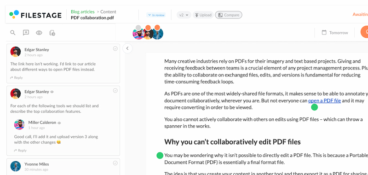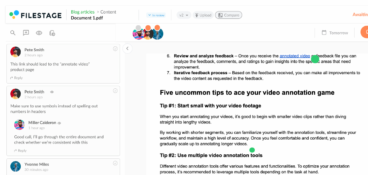When you’re working on a project, the cracks soon start to show if you don’t take the time to engage everyone involved. Without effective stakeholder collaboration, stakeholders can feel overlooked, which can lead to misalignment, misunderstandings, missed deadlines, and all-round mayhem.
But collaborating with stakeholders isn’t always easy. Especially when there are tricky characters and a wide range of perspectives involved. It takes work. But trust me, it’s worth it for project harmony (and success).
So with that in mind, here are eight ways to master stakeholder collaboration in 2024.
But first…
What is stakeholder collaboration?
Stakeholder collaboration, sometimes referred to as stakeholder engagement or business collaobration, is the process of working with various individuals or groups who have a vested interest – or “stake” – in a particular project. These individuals or groups, known as stakeholders, are either internal stakeholders or external stakeholders.
- Internal stakeholders are individuals or groups within your organization, such as your team mates, other departments, and senior leaders
- External stakeholders are outside your organization, such as clients, customers, and partners
The purpose of stakeholder collaboration is to engage everyone involved and work collectively to make joint decisions, achieve common goals, or address shared challenges. Their involvement could be providing feedback, offering skills, contributing knowledge, or sharing resources.
Why is stakeholder collaboration important?
Stakeholder collaboration is important for a whole host of reasons. Here are some of the key benefits:
- Informed decision-making – Stakeholder collaboration gives you access to a wide range of perspectives, expertise, and insights. This leads to more informed and well-rounded decision making.
- Improved problem-solving – On a similar note, bringing together a variety of skills leads to more creative, innovative, and effective problem-solving.
- Increased accountability – When stakeholders are involved in decision-making processes, they’re more likely to feel a shared sense of ownership and responsibility for the outcomes.
- Reduced risks – Involving stakeholders early in a project or decision-making process helps you to identify, address, and manage risks and challenges that may arise before they become major issues.
- Better relationships – Stakeholder engagement promotes open and transparent communication. This helps establish trust and reduces the likelihood of misunderstandings or conflicts.
- Less resistance – By collaborating with stakeholders from early on, you get their buy-in from the start. This reduces the chance of resistance and holdups down the line.
- Efficient use of resources – By pooling resources and expertise, you can save time, money, and duplicate efforts.
So with all that in mind, here are eight ways to master stakeholder collaboration in 2024.
Supercharge your stakeholder collaboration
Share, review, and approve all your content in one place with Filestage.
1. Carry out stakeholder analysis to identify your stakeholders
A stakeholder analysis is the starting point for successful stakeholder collaboration. It’s the process of identifying and assessing all stakeholders involved in your project.
By doing this, you can:
- Identify key stakeholders
- Prioritize stakeholders based on their level of influence and importance
- Understand their interests and expectations
- Identify potential sources of resistance or conflict
- Build positive and collaborative relationships
- Work out how to effectively engage different internal and external stakeholders
Start by listing all of your stakeholders. Every single person that needs to be involved. This will vary massively depending on your project, organization, and industry, but typical internal and external stakeholders might include:
- Team members
- Project managers
- Senior management
- Product teams
- Marketing teams
- Sales teams
- Legal teams
- Finance teams
- Clients
- Partners
- Suppliers
- Customers
Once you have your list of stakeholders, group them where appropriate, then start to assess each individual and stakeholder group and think about how much they need to be involved. Think about who your key stakeholders are: who needs to be kept in the loop at every step? Who’s responsible for final approval?
Carrying out stakeholder analysis right at the beginning will boost your ability to collaborate effectively with everyone involved, which ultimately boosts your chances of project success.
2. Host a workshop to set out roles and responsibilities in Miro
Setting out roles and responsibilities is another essential part of collaborative working. Clearly defined roles and responsibilities help stakeholders understand what’s expected from them – which prevents misunderstandings, and holds them accountable too.
This form of stakeholder management also helps you to create a structured and efficient workflow for your project, reducing the chance of confusion and delays.
Miro is a collaboration platform that allows you to host a real-time workshop with your stakeholders to set out these roles and responsibilities. No matter where you and your stakeholders are in the world, this online whiteboard tool helps bring you all together in a remote but live workshop, where you can clearly and visually set out roles and responsibilities, make collaborative decisions, and get your project off to the best possible start.
Here’s how Miro helps with stakeholder collaboration
- Work together in real time from anywhere in the world
- Use its customizable templates and boards to create whiteboards that meet your needs
- Collaborate and communicate visually with sticky notes, images, mind maps, videos, drawing capabilities, and more
- Save all your ideas in one place for easy reference
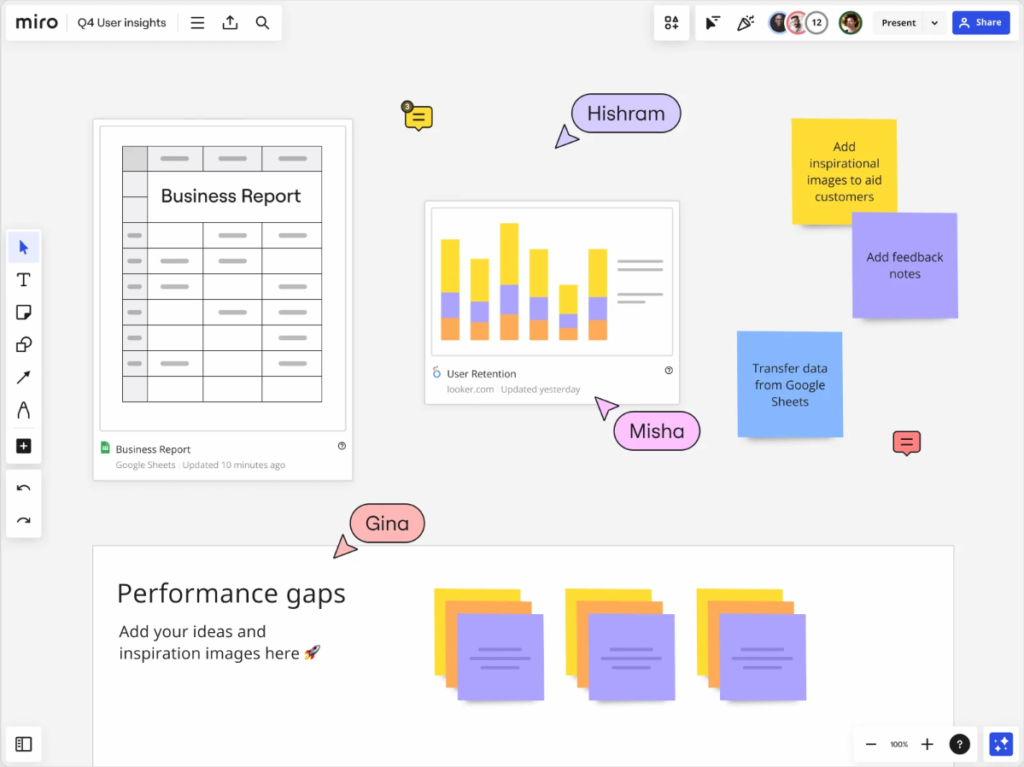
Source: Miro
3. Set up a weekly status call to hold stakeholders accountable
When your project is well underway and time is of the essence, weekly status updates are vital for keeping everything on track and running smoothly. Not only does a weekly status call give you the chance to keep key stakeholders informed about the project’s progress, challenges, and upcoming milestones, it also helps to boost stakeholder input and hold them accountable.
Knowing that progress will be discussed regularly encourages stakeholders to stay focused on their commitments throughout the week, fulfill their responsibilities, and meet deadlines.
If not, then public humiliation awaits!
Setting up a weekly status call on Zoom, Microsoft Teams, Skype, or Google Meet is quick and easy (once you’ve found a time that suits everyone). And even just a short check-in can help to keep things moving forward.
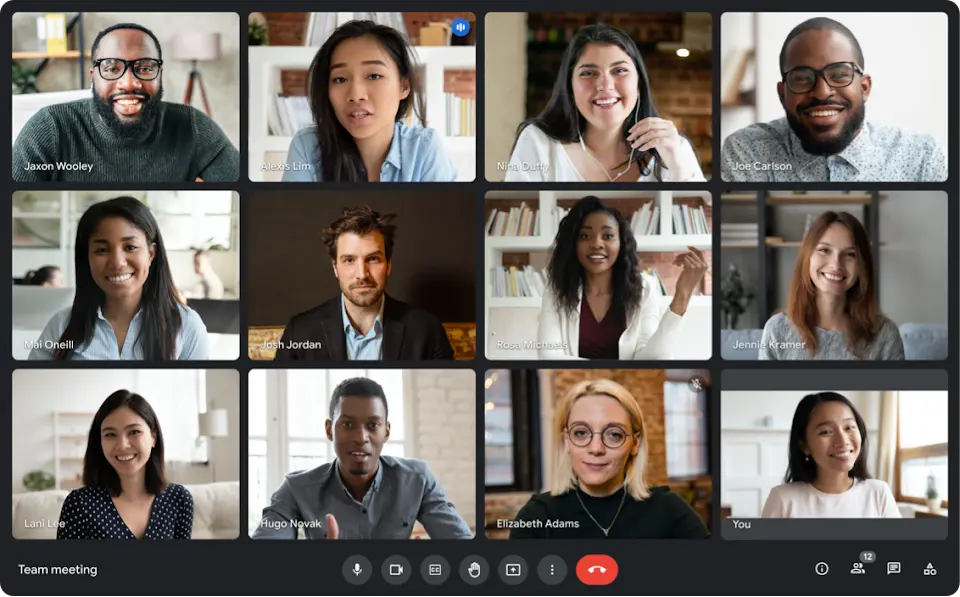
Source: Google Meet
4. Set out a clear stakeholder communication plan
As part of the collaboration process, it’s important to keep communication as slick and effective as possible. Poor communication can leave everyone feeling confused, out of the loop, and disengaged. Clear communication, on the other hand, will build trust and keep stakeholders engaged.
The key is to set out a clear stakeholder communication plan. This should outline:
- The communication channels you’ll use for keeping in touch
- How frequently you plan to communicate
- The type of information you’ll share (such as progress, challenges, and milestones)
- How quickly a response is expected
When stakeholders know how and when they will receive information (and what’s expected from them in return), they’re more likely to actively participate in your project. By setting out a clear plan, you not only manage expectations, but you also demonstrate your commitment to openness and transparency, which sets a positive tone for how you collaborate with stakeholders.
5. Give stakeholders context when sharing new information using Loom
Keeping everyone up to date with new project information is a must for successful stakeholder collaboration. It helps stakeholders see the bigger picture, keeps them engaged, and helps them to make informed decisions.
But it can be hard to give all the necessary context in the space of an email. And finding a time that suits everyone for an ad-hoc project update can be nothing short of a nightmare.
Loom allows you to record messages to send to your stakeholders. You can record your camera, microphone, and desktop as you walk your stakeholders through a process, explain a roadmap, or answer a complicated question. And stakeholders can watch the recordings at a time (and pace) that works for them.
Here’s how Loom helps with stakeholder collaboration
- Record your screen, face, and voice at the same time to share context clearly with stakeholders
- Save videos to the cloud and share them instantly with a link
- Add links to relevant files and resources for your stakeholders to reference
- Stakeholders can add comments and react to your video with emojis
- Get notified when someone views, reacts, or comments on your video
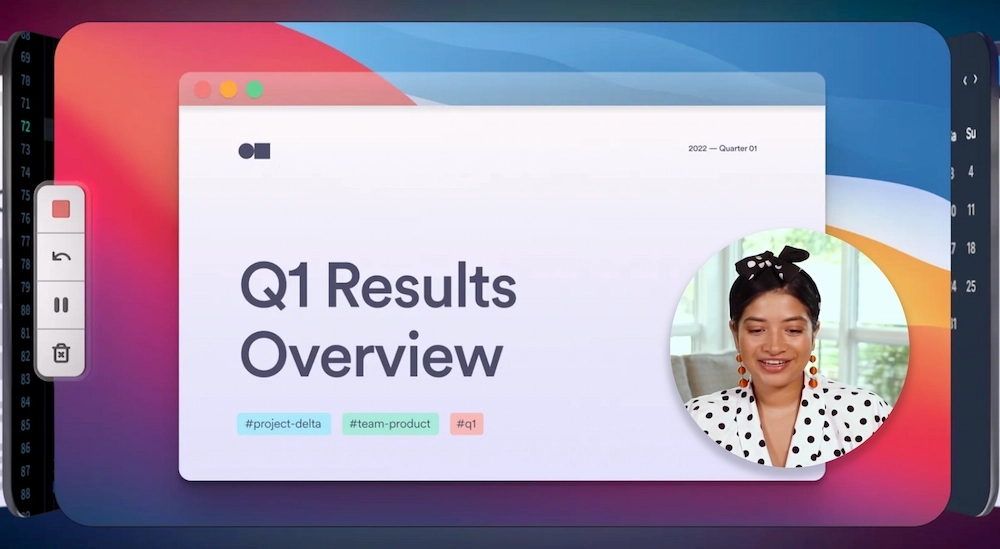
Source: Loom
6. Get collaborative feedback on any file format in Filestage
Feedback is a key part of stakeholder collaboration. It helps with identifying problems or mistakes, understanding how to improve, and moving a project forward towards completion. And it’s great for engaging stakeholders and making them feel valued.
But it’s important to give stakeholders a clear and easy way to provide feedback on your project. If not, then chaos awaits.
Filestage is a collaborative review and approval tool that helps you and your stakeholders to give, collect, and discuss feedback on all sorts of content and file formats – from documents and designs to videos and websites. All in one place.

From sharing to approval, it makes the process of collaborating on files and getting feedback and approval faster, simpler, and less stressful for everyone involved.
With Filestage, you can set due dates to let your stakeholders know how long they have to provide feedback, and you can create reviewer groups to invite different stakeholders at different stages of the process.
Here’s how Filestage can help with stakeholder collaboration
- Share and review designs, documents, websites, video, and all your other content
- Create reviewer groups for each stage of your project and invite different stakeholder groups to different steps
- Set due dates to help everyone know what needs doing when
- Leave in-context comments and visual annotations, and add attachments
- Tag other stakeholders to discuss feedback and iron out any disagreements there and then
- Turn comments into a to-do list, so your team has a clear picture of what needs amending
- Keep track of the project status using the project dashboard and see who’s left to review the designs
Supercharge your stakeholder collaboration
Share, review, and approve all your content in one place with Filestage.
7. Adapt to the different characters in your review process
It’s a well-known fact that different people have different communication styles. And this is certainly true of stakeholders when it comes to your review process.
There are key characters that come up again and again. And many of them are problematic in their own unique way. These characters include:
- The one who comments on every single thing, even the stuff that clearly isn’t finished
- The one who sends one comment at a time, leading to lots of unnecessary review rounds
- The one who changes their mind or forgets all about their previous feedback
- The one who writes long-winded comments that take hours to unpick
- The one who replies to the email chain without reading anyone else’s feedback
- The one who you constantly have to chase for feedback and approval

It can be challenging to manage these tricky individuals, but by thinking about the different characters among your diverse stakeholders upfront, you can adapt, make a plan, and level up your stakeholder management game.
For example, for some characters you might need to be really specific about the kind of feedback you’re looking for so they don’t overstep the mark. For others, you might need to set very clear due dates so you don’t end up missing important deadlines.
Our article on stakeholder communication sheds more light on these key characters you’re likely to encounter, and offers useful tips on how to handle them.
8. Invest time in building positive relationships with stakeholders
All relationships take work. And even though you may never come face to face with many of your stakeholders, building positive relationships is essential for successful stakeholder engagement. Positive relationships help to build trust and create an environment of open communication, which ultimately leads to more effective collaboration.
Here are some things you can do to build positive relationships with your stakeholders:
- Take the time to understand the unique needs, expectations, and concerns of your stakeholders
- Build rapport by being approachable, responsive, and showing genuine interest in their contributions
- Practice active listening during meetings and interactions so that your stakeholders feel heard
- Acknowledge and appreciate the contributions of stakeholders to foster a sense of value and importance
Final thoughts
Mastering stakeholder collaboration is an ongoing process that requires a combination of skills, communication strategies, and a commitment to building and maintaining positive relationships. It takes work, but it’ll all be worth it when you achieve those all-important project goals.
If you’d like to see for yourself how Filestage can help with stakeholder collaboration during the review and approval process, you can start a free trial here →



